8 Radishes Including Summer Varieties (Harvested Sooner) And Winter Types

VEGETABLES > RADISHES > VARIETIES
Reviewed By PETER LICKORISH

Peter is a Horticulture Lecturer and self-employed Horticulturist, with a passion for diverse areas of the industry - from garden design to the science behind plant growth and propagation. He has completed the Royal Horticultural Society’s Master of Horticulture (MHort) Award and lectures on RHS courses at Bedford College.
IN THIS GUIDE
RADISH GUIDES
Container Growing
Varieties
Radishes are broadly divided by season of harvest and by shape and size.
Summer radishes are distinctly smaller than winter radishes and are ready for harvest much sooner.
Summer Varieties
Summer varieties are broadly divided into ‘globe’ which are the familiar round varieties and the ‘icicle’ types with elongated shapes.
Summer radishes are not only easy to grow, they are especially quick-growing vegetables so that within several weeks the gardener’s efforts yield results that are edible and tasty!
As such, summer radishes are an excellent choice as an ‘entry level’ vegetable for the gardening beginner, or to get kids started on growing veggies.

Because summer radishes are small in size and so quick to crop, they are an ‘in-between’ vegetable in more ways than one:
- First, their size allows them to be planted in between rows of other, larger vegetables – and in small, unused patches of the vegetable garden, to fill in the gaps.
- Second, because they can be harvested in about four weeks, they can be sown and enjoyed in between the points in time that an earlier vegetable has been harvested and a later one is yet to be sown and grown.
All of the following summer radishes are cultivars of R. sativus – ‘Small Radish’ or ‘Western Radish’.
1) ‘Cherry Belle’

An heirloom variety and one of those that defines radish to European eyes, being little, round and red.
It is succulent with a relatively mild flavour.
Among summer radishes, it is also relatively forgiving if picked a little late.
One of the fastest-growing summer radishes, it is ready to be harvested in only three weeks when it is about 2.5cm wide.
2) ‘Scarlet Globe’
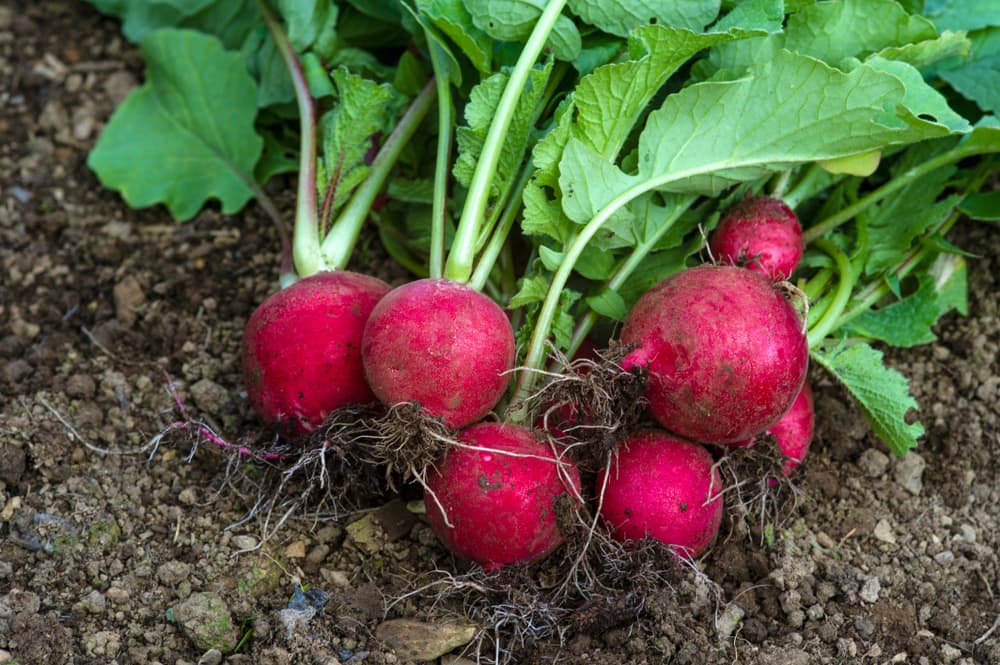
Aptly described by its name, it is not too different from ‘Cherry Belle’ except for being just a little bigger, and good for harvest in about four weeks at an average size of about 3cm.
It too is succulent with a relatively mild flavour.
But another difference is that it is not an heirloom variety but is an RHS Award of Garden Merit recipient.1Raphanus sativus “Scarlet Globe.” (n.d.). Royal Horticultural Society. Retrieved March 23, 2023, from https://www.rhs.org.uk/plants/119407/raphanus-sativus-scarlet-globe/details
3) ‘French Breakfast’
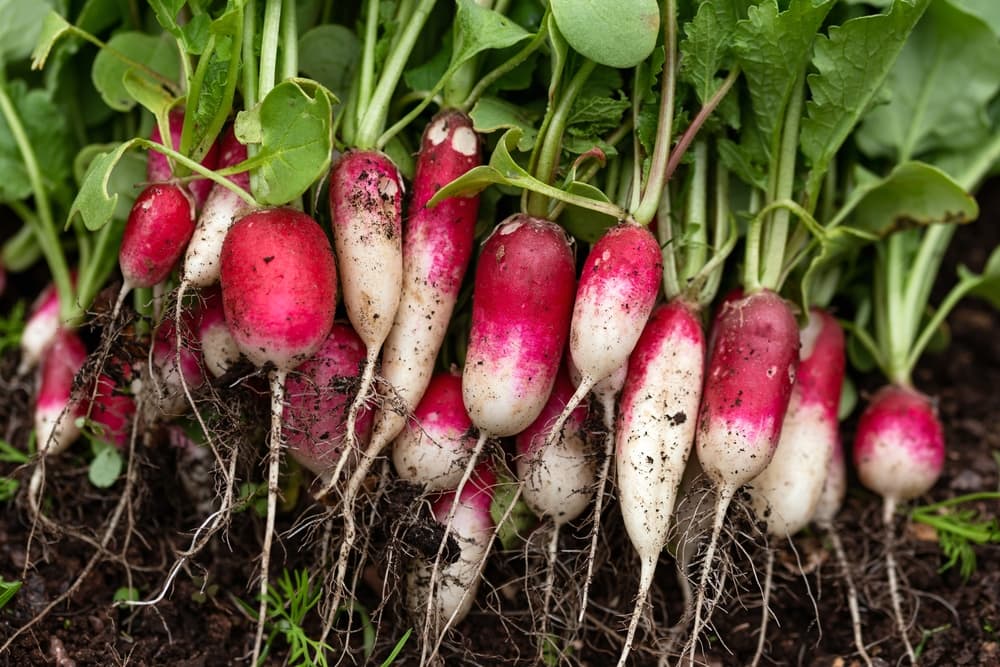
Really does originate from France and in some parts of France it is actually enjoyed as a snack, though maybe not for morning breakfast!2Damrosch, B. (2011, April 20). The French Breakfast radish makes a handy snack. Washington Post. Retrieved March 23, 2023, from https://www.washingtonpost.com/lifestyle/home_garden/the-french-breakfast-radish-makes-a-handy-snack/2011/04/12/AF6E8uBE_story.html
This heirloom variety has a cylindrical shape, is a bright red above while the lower third or merely the lower tip is white.
It is big for a summer radish with a length averaging 6cm.
It is a mild but flavourful variety that is ready for harvest in about four weeks.
4) ‘Sparkler’

In appearance may be thought of as a mix of ‘Scarlet Globe’ and ‘French Breakfast’ – it is about the same shape and size as the former with the colouration of the latter, being a bright red with the lower third or only the tip being white.
It is crunchy and mild in taste, and is considered one of the earliest summer radishes that can be sown.
Ready in about four weeks; recipient of the RHS Award of Garden Merit.
Winter Varieties
Larger winter radishes are usually called Daikon, but it is incorrect to refer to all winter types by this term as there are also Chinese winter varieties and the Black Spanish variety.
On the other hand, winter radishes have their own singular strength and standout charm, for how many other flavourful and culinary vegetables will keep growing and be good for harvest through the cold and grey Decembers and Januaries, the dead of winter!
Furthermore, just when you would like a bit of spicy zing to your winter dishes, there’s that flavourful radish you had sown back in October!
5) Chinese Radish
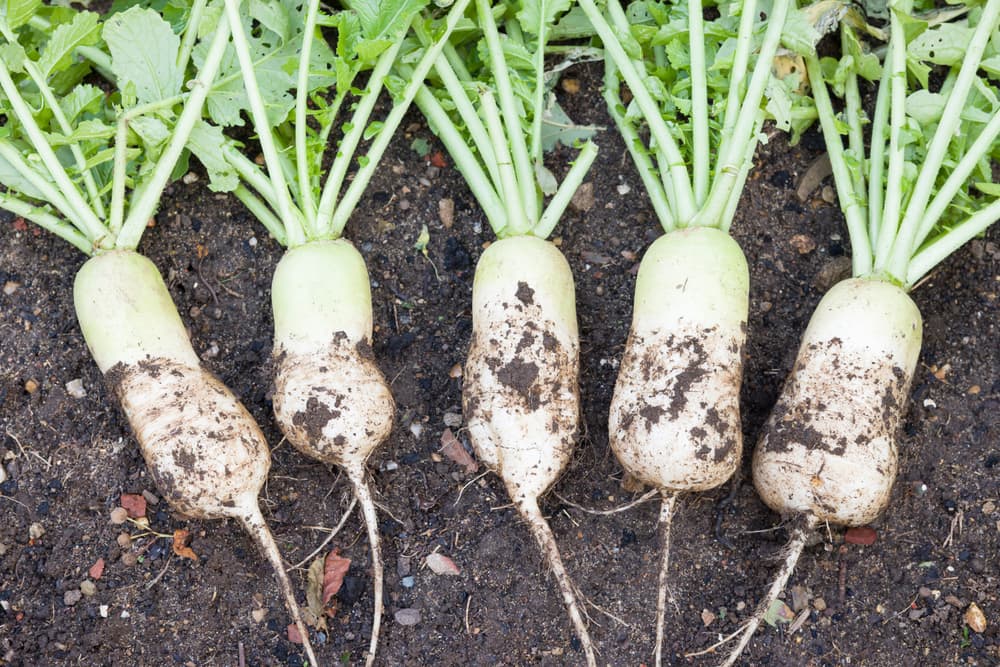
AKA: ‘Longipinnatus’ or ‘Mooli’
A daikon, perhaps the classic daikon.
It is dirty white and ungracefully cylindrical in shape.
Typically about 40cm long, it can attain lengths of 50cm+ when allowed to mature.
As it grows, about a third of this radish is above the soil’s surface.
It is on the mild side for a winter radish but does not have the light mouth-feel of summer radishes.
It is used throughout East Asia and South Asia in a vast variety of savoury dishes, further to which condiments, pickles and such are also made from it.
6) ‘Black Spanish Round’
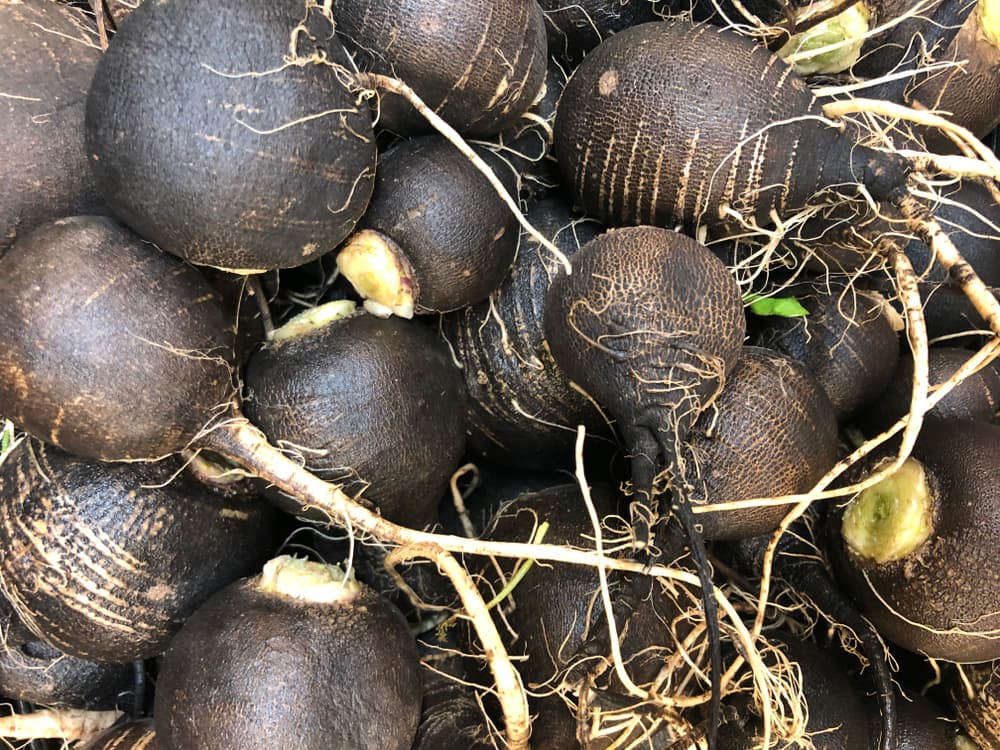
A radish with a reputation.
It has a definite kick, rather like a horseradish – it is spicy, perhaps too spicy for some.
Another elongated form is also cultivated; it is not quite as spicy.
Both kinds are often as black as coal from the outside and as white as snow inside.
The round variety is a proper heirloom plant, going back to the 16th Century.
Not properly round, it is lumpily round or pear-shaped.
Ready to harvest when it is about 10cm wide in 60-70 days, even by winter radish standards this one keeps well.
It is best used in savoury, spicy soups and dishes.
7) ‘China Rose’
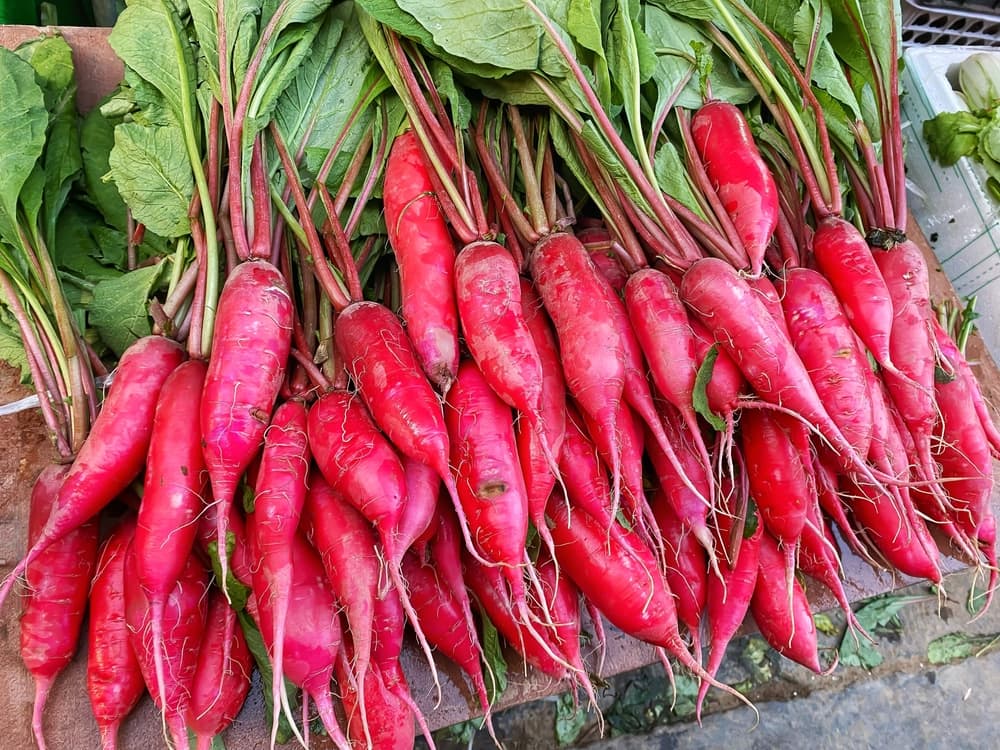
A variety from China that is rose-red in colour.
This daikon is cylindrical, rather tube-like, in shape.
It grows to 15-20cm in length and 5cm in diameter so it is on the small side for a winter radish.
Making up for it, this one is flavourfully spicy rather than overly so.
As such, it can be enjoyed raw with Spanish or Tex-Mex foods but this versatile daikon can also be used for making soups, stocks and stews.
It is ready for harvest in right around eight weeks.
8) ‘Miyashige’

Hails from Japan.
It is off-white and carrot-shaped, typically growing to 35-40cm long and 7-7.5cm in diameter.
It is ready to be pulled up in 50-60 days when it has not reached its full size.
Not spicy but quite mild, this radish is succulent and flavourful.
A great choice if you want to try Japanese or Korean cuisine at home, this radish is also a versatile one as it can be sliced raw into salads, quickly sauteed, or pickled and stored.
“If, like me, you find strong spices have you reaching for jugfuls of water, you are safest regarding winter radishes as a culinary vegetable, with ‘Miyashige’ being the only one to eat raw,” shares Master Horticulturist Peter Lickorish.
“I also have a preference for the narrow varieties, simply because they can be packed in a little tighter.
“That said, cramming too tightly will often lead to bolting, so go by the recommended spacing on a seed packet.”
References
- 1Raphanus sativus “Scarlet Globe.” (n.d.). Royal Horticultural Society. Retrieved March 23, 2023, from https://www.rhs.org.uk/plants/119407/raphanus-sativus-scarlet-globe/details
- 2Damrosch, B. (2011, April 20). The French Breakfast radish makes a handy snack. Washington Post. Retrieved March 23, 2023, from https://www.washingtonpost.com/lifestyle/home_garden/the-french-breakfast-radish-makes-a-handy-snack/2011/04/12/AF6E8uBE_story.html

